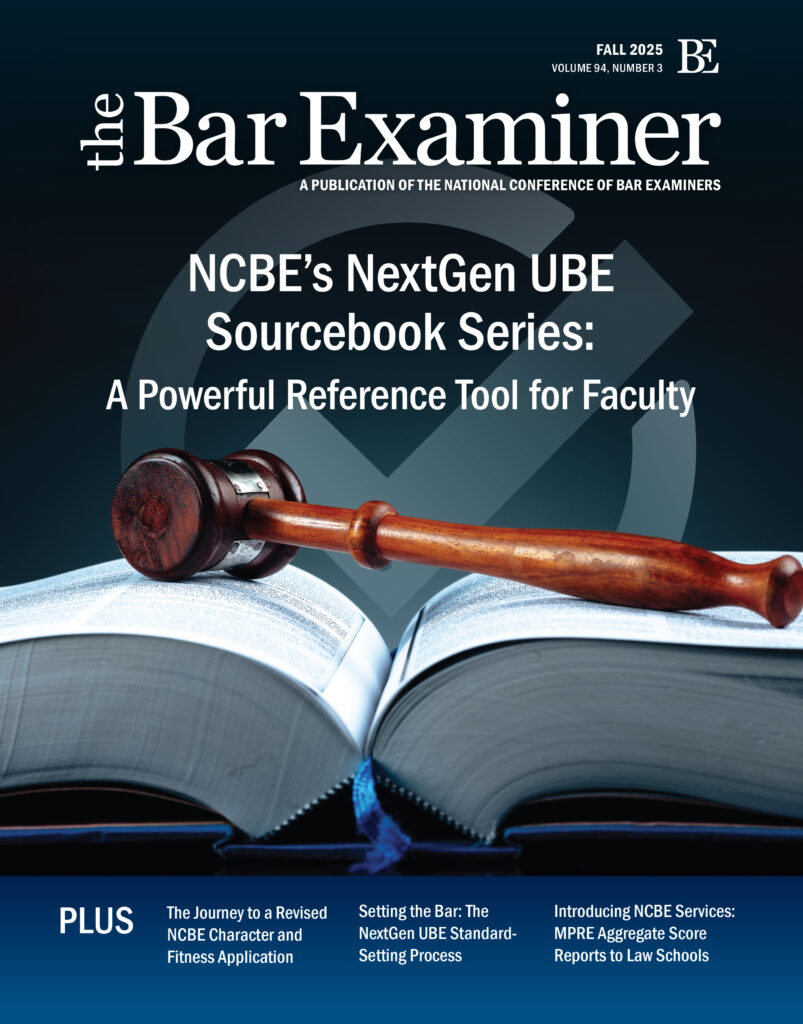This article originally appeared in The Bar Examiner print edition, September 2015 (Vol. 84, No. 3), pp 4–5.
By Erica Moeser
 Now we are 18—the Uniform Bar Examination continues to grow. As reported earlier, Kansas and New York have joined the ranks and will begin UBE administrations in February 2016 and July 2016, respectively. More recent additions are Iowa—to begin in February 2016—and Vermont—to begin in July 2016. There is increasing interest in exploring what the UBE is all about, fueled perhaps by New York’s embrace of the test, and several NCBE staff members and volunteers have taken to the roadways and skies to appear before Supreme Courts and boards of bar examiners in our ongoing efforts to educate people about the test. We have found that these state forums are the most effective way to explain what the UBE is and isn’t, and to address the concerns that are understandable for those unfamiliar with what the UBE is all about. Welcome and thank you, Iowa and Vermont!
Now we are 18—the Uniform Bar Examination continues to grow. As reported earlier, Kansas and New York have joined the ranks and will begin UBE administrations in February 2016 and July 2016, respectively. More recent additions are Iowa—to begin in February 2016—and Vermont—to begin in July 2016. There is increasing interest in exploring what the UBE is all about, fueled perhaps by New York’s embrace of the test, and several NCBE staff members and volunteers have taken to the roadways and skies to appear before Supreme Courts and boards of bar examiners in our ongoing efforts to educate people about the test. We have found that these state forums are the most effective way to explain what the UBE is and isn’t, and to address the concerns that are understandable for those unfamiliar with what the UBE is all about. Welcome and thank you, Iowa and Vermont!
The results of the July 2015 Multistate Bar Examination (MBE) were sent to jurisdictions a few weeks ago. As anticipated, the national mean score dropped again—to 139.9. Last year’s mean score of 141.5 (on a 200-point scale) garnered a tremendous amount of press attention and more than the usual analysis and speculation about the reasons underpinning the drop from the July 2013 mean score of 144.3.
Over the course of the past year, that analysis pointed to the probability that the scores earned in July 2015 would represent the continuation of a downward slide, and that is what we can now confirm. At 139.9, this July’s mean MBE score is the lowest July score since 1988, when it was 139.8.
Significantly, the number of July test takers dropped by five percent from the prior July, from 51,005 to 48,384, and that represents the lowest number of July examinees since 2004, when 47,433 tested. That number is not surprising, given that entering enrollment at ABA-accredited law schools declined by almost nine percent between 2011 (the class that graduated in 2014) and 2012 (this year’s graduating class).
In my column in our last issue (June 2015), I appended a chart listing by law school the LSAT score that marks the top of the bottom quartile of matriculants for 2010 to 2014. Computing the average of those scores reveals that the LSAT score dropped from 154 to 153 from 2011 to 2012. (The top of the bottom quartile dropped further to 152 for the 2013 matriculants, representing the graduates who will emerge and be tested in July 2016; the 2013 entering class had an additional eight percent drop in enrollment from 2012.)
In short, there should be few surprises for those who watch the interplay of law school enrollments, law school predictors, and MBE results. This is the “new normal,” and the new normal will be with us for a while. Of course, every jurisdiction has its own processes and dynamics, so one can only generalize so far.
The past year, laced intermittently with controversy as it was, gives me reason to repeat a few things I have written in columns along the way: (1) The MBE is merely the messenger. It is the consistent measure against which applicants are assessed. (2) Each jurisdiction sets its own standards for admission. Press accounts suggesting that NCBE sets standards are incorrect. (3) Written portions of the bar examination are locally graded. (4) Regrading practices vary from jurisdiction to jurisdiction. (5) Decisions about how components of the bar examination are weighted vary by jurisdiction, except in jurisdictions that administer the Uniform Bar Examination, where the MBE is consistently weighted at 50%. (6) Longer-term comparisons of LSAT scores of entering candidates should take into account the shift that occurred in 2011 to the reporting of the highest LSAT score rather than an average of all LSAT scores for an individual.
And, of course, there are many variables to consider in examining the overall pass rate in any given jurisdiction. While law school enrollments and predictors tied to entrance in law school (such as the LSAT score) are factors, they do not tell the complete story. Obviously, not all matriculants graduate from the law school they entered, nor do all new graduates take the bar examination in the state of graduation. Overall pass rates are affected by the number of repeaters sitting, and this in turn may be a factor of the pass/fail line set by the testing jurisdiction; that is, jurisdictions with higher cut scores create more repeaters.
The other significant factor is the alchemy of the law school experience itself. In my opinion, to the extent that there are strong faculty-wide pedagogical efforts to address the needs of law students—particularly those students who would benefit from feedback and repetition—the bar examination as a performance measure at the end of three years of legal education will reward the schools that are most committed to meeting educational needs in ways that are pervasive in the curriculum. Stated another way, if one normalizes for entrance predictors, law schools that engage the entire faculty in meeting the challenges will outperform law schools that stick to traditional approaches or compartmentalize academic assistance to a few individuals working in the institution. One might say, “It takes a village . . . .”
From a strategic standpoint, I would think that reinforcing learning in the seven areas covered by the MBE (all core curriculum subjects) would have a place in the third year, not as a learn-the-test-tricks activity but to offer some “aha moments,” especially for students whose educational maturation may allow them to make better use of the knowledge later in their law school experience when law may have become less abstract through experiential settings. Since MBE topics customarily also appear in the written portions of bar examinations, the odds of improving bar performance are enhanced by attention to those seven topics.
This August marked the conclusion of Bryan Williams’s year as NCBE Chair and the beginning of Judge Tom Bice’s term. Bryan kept the trains running on time, as no doubt Tom will, too. Tim Wong of Minnesota has joined the Board as a Trustee.
This summer also marked the complete retirement of the seemingly immortal Fred P. Parker III of North Carolina from the ranks of bar admission administrators. At retirement, Fred was the senior active administrator in the country. Fred was generous in assisting colleagues across the country throughout his career. This issue contains Fred’s last Litigation Update, to which he has contributed since 1991, and concludes his 18 years of service on our Editorial Advisory Committee. He was the “reference librarian” for administrators: if a case arose about bar examining anywhere in the United States, Fred knew about it. He is the quintessential Southern gentleman, and we wish him the happiest of retirements—and hope for occasional sightings!
Finally, the bar examining world has lost a giant. John Germany of Florida died in late August. His name may be unfamiliar to today’s readers, but I assure you that all of us stand on his shoulders. As a lion in the bar, he championed the MBE at its very beginning, and his advocacy and leadership were significant in generating support and acceptance of the wild notion that bar applicants could be evaluated by multiple-choice questions. John was a parent of the MBE, which was first administered in 1972, and his two-year stint as NCBE Chair between 1974 and 1976 provided the pulpit from which he preached its usefulness and fairness. John Germany was a courtly, accomplished lawyer who also managed to be a game-changer. The MBE is his legacy.
Contact us to request a pdf file of the original article as it appeared in the print edition.







